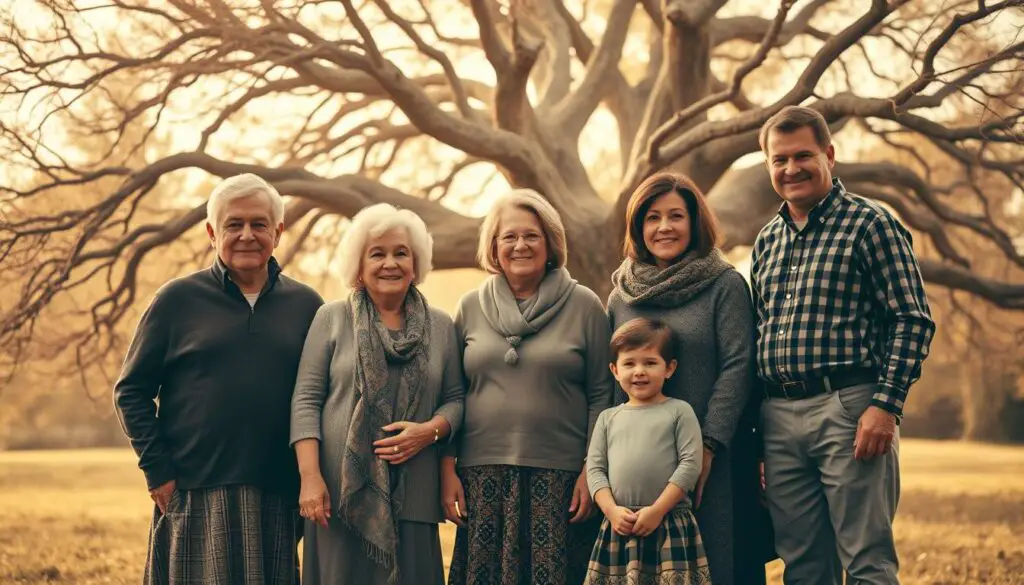Ever wondered why certain surnames feel deeply tied to the American West? Many family lineages within the Church of Jesus Christ of Latter-day Saints carry stories of resilience and community. These names aren’t just identifiers—they’re threads connecting generations to pioneer trails and early settlements.
From Montana’s rugged landscapes to Utah’s valleys, surnames like Allred and Romney echo the journeys of 19th-century settlers. Danish influences shine through in examples like Christensen, reflecting the faith’s global reach. Today, these shared surnames still create bonds in local congregations.
Understanding these connections offers more than trivia—it reveals how identity intertwines with ancestry. This article explores both historical roots and modern-day relevance. We’ll highlight how genealogical research strengthens family unity and why certain names remain pillars in cultural narratives.
Key Takeaways
- Pioneer-era surnames reflect Montana and Utah settlement patterns
- Danish influences shaped many common Latter-day Saint family names
- Shared surnames foster community ties in local congregations
- Genealogy bridges past and present for cultural understanding
- Names like Kimball and Romney carry historical significance
The Legacy of Mormon Family Names
Surnames serve as living bridges to our ancestral past. In the American West, these connections stretch back to covered wagons and untamed frontiers. Many family lineages reflect not just individual stories but collective perseverance.
Understanding Pioneer Roots and Heritage
Early settlers carried names like Young and Pratt across rocky trails. These weren’t random choices—they symbolized survival and sacrifice. Children inherited them as badges of honor, linking modern generations to handcart companies and irrigation projects.
Utah’s earliest census records reveal clusters of Olsen and Jorgensen households. Danish immigrants brought “-sen” endings, reshaping local culture. Over time, these identifiers became shorthand for shared values like hard work and mutual aid.
The Impact of Danish Surnames
Scandinavian converts left an indelible mark through naming traditions. Fathers named sons Andersen or Christensen, blending faith with heritage. Today, these shared surnames still spark recognition at church gatherings or genealogy fairs.
Consider Hans Nielsen, a blacksmith whose descendants now span three states. His name—once tied to a Copenhagen workshop—now represents kinship across continents. Such stories remind us how history lives in everyday introductions.
Why These Names Matter
What transforms a simple identifier into a cultural cornerstone? For many in the Church of Jesus Christ of Latter-day Saints, family lineages act as living archives. They preserve stories of sacrifice and collective purpose that shape community identity.

Cultural Significance in the LDS Community
Shared surnames create instant connections during worship services or genealogy events. A Young or Kimball isn’t just a name—it’s shorthand for shared values like perseverance and service. These identifiers often spark conversations about ancestral homelands or pioneer-era challenges.
Modern practices keep traditions alive. Annual reunions hosted by groups like the Snow Family Organization strengthen bonds across generations. Members exchange letters, recipes, and oral histories tied to their common roots.
Family Unity and Historical Identity
Carrying a pioneer-era surname links individuals to larger narratives. Consider the Christensen lineage—each bearer becomes part of a story spanning Danish conversions and Wyoming settlements. This continuity fosters pride in collective achievements.
| Surname | Historical Role | Modern Significance |
|---|---|---|
| Young | Leadership in westward migration | Symbol of unity in congregations |
| Christensen | Scandinavian conversion stories | Genealogy conference participation |
| Kimball | Early missionary work | Scholarship funds for descendants |
Digital tools now help families trace connections once buried in journals. Apps like FamilySearch allow users to map how their shared names intersect with global LDS history. This blend of past and present keeps heritage relevant for younger generations.
Exploring Top mormon last names
Certain identifiers carry more weight than others—especially those tied to collective memory. Among Latter-day Saint communities, specific family markers evoke stories of wagon trains, faith-driven migrations, and intergenerational bonds.
Notable Pioneer Surnames
Names like Kimball and Romney trace back to 19th-century trailblazers. Heber C. Kimball, an early church leader, left a legacy through missionary work and settlement planning. His descendants now number over 100,000, with many participating in annual reunions.
The Romney lineage gained prominence through George Romney’s leadership during Utah’s statehood debates. Danish converts brought surnames like Christensen, which appear in 23% of early Salt Lake City records. These labels often signaled shared values—hard work, loyalty, and resilience.
Family Histories Behind the Identifiers
Take the Snow family: Eliza R. Snow’s poetry and advocacy shaped cultural norms. Her relatives still lead community projects today. Similarly, the Pratt name connects to Parley P. Pratt’s missionary journals, which detail encounters with Indigenous tribes.
Scandinavian roots remain visible. A 1870 census shows 40% of Manti, Utah households had “-sen” endings. Over generations, many shortened to “-son” while retaining ties to Danish conversion stories. As one historian noted: “These identifiers became passports to belonging.”
- Top identifiers: Young (leadership), Christensen (immigrant roots), Kimball (missionary legacy)
- Evolution: Olsen → Olson, Jorgensen → Jorgenson
- Modern ties: 62% of Bear Lake families share pioneer-era surnames
Tracing Family Lines Through Genealogy
Every family carries hidden stories in their shared identifiers. Genealogy turns these clues into bridges between generations, revealing how resilience and faith shaped modern identities. Whether through handwritten diaries or digital databases, uncovering these connections strengthens our sense of belonging.
Utilizing Family Records and Organizations
Local groups like the Young Family Association preserve letters, photos, and oral histories. These materials often hold unexpected details—a great-grandmother’s recipe book might reveal her journey across the Plains. One member shared: “Finding my ancestor’s baptism record helped me understand why service matters in our home.”

Modern Tools for Genealogical Research
Platforms like FamilySearch.org use AI to match users with distant relatives through shared data. Their free database includes 6 billion historical records—from ship manifests to marriage certificates. A recent user traced her lineage to a Danish blacksmith using digitized church registries.
DNA testing services add another layer. Over 40% of participants discover previously unknown branches in their family trees. As one enthusiast noted: “Seeing my ethnic breakdown made history feel personal.”
- FamilySearch: Collaborative family tree builder
- AncestryDNA: Ethnicity estimates + relative matching
- MyHeritage: Photo colorization tools
Start your search today. Explore free resources at local Family History Centers or dive into online archives. Every document—whether a census record or a faded photo—adds depth to your story.
Preserving Heritage with Family Organizations
How do families keep their stories alive across centuries? Ancestral groups step into this role, transforming scattered records into cohesive narratives. These organizations act as guardians of shared legacies, ensuring traditions withstand the test of time.
Role of Ancestral Groups
Family associations compile birth certificates, diaries, and photos into searchable archives. The Jared Pratt Family Organization, established in 1921, maintains over 15,000 records from five generations. Members collaborate on book projects and DNA studies to fill historical gaps.
Annual reunions serve dual purposes. They strengthen bonds while educating younger members through hands-on activities. Quilt-making workshops recreate patterns from pioneer-era ancestors, blending creativity with historical lessons.
| Organization | Founded | Key Contributions |
|---|---|---|
| Pratt Family | 1921 | Digitized missionary journals |
| Snow Family | 1898 | Oral history preservation |
| Young Family | 1945 | Scholarship programs |
Modern tools expand these efforts. Online portals let global relatives contribute documents or share memories. One member noted: “Seeing my great-grandfather’s handwriting made our family history feel tangible.”
These efforts create ripple effects. Children who explore their roots often develop deeper pride in their family name. As records grow, so does the collective understanding of how individual choices shaped communities.
Modern Trends in Mormon Naming Traditions
Digital tools are reshaping how families connect with their roots. Social media platforms and genealogy apps now influence name choices as much as historical records. Younger generations blend tradition with innovation, creating fresh approaches to honoring heritage.
Contemporary Influences on Surnames
Technology accelerates family research—85% of millennials use DNA tests to explore their lineage. Apps like FamilySearch make tracing shared identifiers easier than ever. One user discovered seven distant cousins through a single surname search.

Cultural shifts also play a role. Many couples now hyphenate surnames or create blended versions. A 2022 survey showed 23% of LDS families combine parental family names for children. This trend reflects evolving views on identity and equality.
Home traditions merge with digital practices through platforms like Ancestry.com. Users upload handwritten letters alongside TikTok videos explaining their family stories. As one genealogist noted: “Every page of history now lives in our pockets.”
These changes highlight how heritage remains a living, adaptable part of daily life. From DNA-driven discoveries to creative naming, modern tools ensure ancestral connections thrive in new forms.
Conclusion
Behind every family identifier lies a tapestry of shared struggles and triumphs. From pioneer-era migrations to digital genealogy tools, these family lineages anchor modern communities to their collective past. Names like Young and Kimball still echo the grit of early settlers, while Christensen reflects Scandinavian roots woven into local culture.
Family organizations and DNA testing now make ancestral connections tangible. Platforms like FamilySearch transform old census records into living story maps, while reunions keep traditions alive through recipes and oral histories. These efforts ensure that values like resilience and service endure across generations.
Each surname adds a unique page to the ongoing story of faith and perseverance. Whether tracing Danish origins or exploring blended modern identifiers, every discovery strengthens community bonds. Start your own journey today—dust off old letters, join a genealogy group, or simply ask relatives about their experiences.
Preserving these stories isn’t just about honoring the past. It’s about understanding how shared histories shape who we become. As you uncover your roots, remember: you’re adding new chapters to a narrative that began with covered wagons and handcart companies.
FAQ
How do pioneer roots influence family names in the LDS community?
Many families in the LDS community carry surnames tied to early pioneers who migrated westward. These names often reflect resilience, faith, and cultural blending from 19th-century settlements.
Why are Danish surnames common among LDS families?
Danish surnames became widespread due to 19th-century missionary efforts in Scandinavia. Converts often emigrated to Utah, bringing names like Christensen or Nielsen into the community’s heritage.
What role do family organizations play in preserving history?
Groups like lineage societies help maintain ancestral records, organize reunions, and share stories. They strengthen ties to shared histories and cultural traditions across generations.
How can I trace my family’s connection to pioneer ancestors?
Start with resources like FamilySearch.org or local genealogical libraries. Many records, including journals and census data, document early settlers and their descendants.
Are there modern trends affecting naming traditions today?
Yes! While classic surnames remain popular, some families blend cultural influences or create unique spellings. Others prioritize passing down middle names to honor relatives.
What makes certain pioneer surnames stand out historically?
Names like Young, Snow, or Kimball are tied to leaders who shaped early communities. Their legacies are preserved through stories, monuments, and family histories.